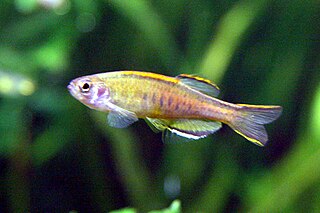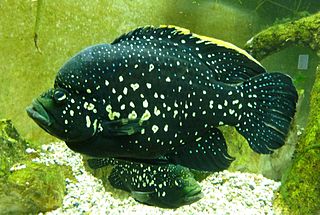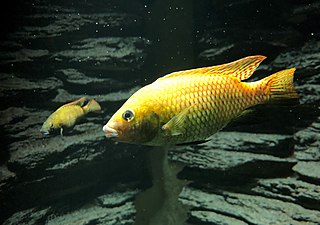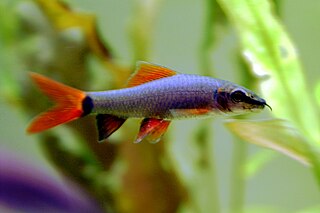
The giant danio is a tropical fish belonging to the minnow family Cyprinidae. Originating in Sri Lanka, Nepal, and the west coast of India, this species grows to a maximum length of 4–6 inches (10–15 cm), making it one of the largest of the danionins. It is characterized by a blue and yellow, torpedo-shaped body with gray and clear fins.
The queen danio or Fowler's danio is a freshwater tropical fish belonging to the minnow family (Cyprinidae). Originating in India, Myanmar, Thailand, northwestern Malaya, and the Mekong River basin, this fish is sometimes found in community tanks by fish-keeping hobbyists. It grows to a maximum length of 3.1 in (7.9 cm).

The Malabar danio is a tropical fish belonging to the minnow family (Cyprinidae). Originating in Sri Lanka and the west coast of India, the fish has been circulated throughout the world through the aquarium fish trade. It grows to a maximum length of 6 in (15 cm) but rarely exceeds 4 in (10 cm) in a home aquarium.

Inle Lake, a freshwater lake located in the Nyaungshwe Township of Shan State, part of Shan Hills in Myanmar (Burma). It is the second largest lake in Myanmar, with an estimated surface area of 44.9 square miles (116 km2), and one of the highest at an elevation of 2,900 feet (880 m). During the dry season, the average water depth is 7 feet (2.1 m), with the deepest point being 12 feet (3.7 m). During the rainy season, this can increase by 5 feet (1.5 m).

The glowlight danio is a small, schooling fish closely related to the popular zebrafish Danio rerio. This should not be confused with the GloFish, a trademarked brand of fluorescent zebrafish that appear to glow in the dark under ultraviolet light.

Danio kyathit, also called ocelot danio, is a small, schooling species of fish in the family Cyprinidae. It is endemic to the upper reaches of Irrawaddy River near Myitkyina in northern Myanmar. Described in 1998, it is closely related to the better-known zebrafish or zebra danio, D. rerio.
The blue moon danio is a species of cyprinid fish endemic to Myanmar. First described in 2009, they are found in small forested streams on the western slope of the Arakan Mountains in Rakhine State of south-western Myanmar; these streams are typically reduced to a series of interconnected pools during the dry season. This species has also been imported to Europe as aquarium fishes with the code names “TW02” and “Broken Line”.
Devario chrysotaeniatus, commonly called the gold-striped danio, is a tropical fish belonging to the minnow family (Cyprinidae). Originating in China and Laos in the upper Mekong river, this fish is very rarely found in community tanks by fish-keeping hobbyists. It grows to a maximum length of 3 inches (7.5 cm).

Microdevario kubotai is a species of cyprinid found in southeast Asian rivers and streams. It belongs to the genus Microdevario, which contains small danionins. The type locality is in Ranong Province, Peninsular Thailand. It is also known from the adjacent Phang Nga Province and the Ataran basin in Myanmar. It likely occurs elsewhere in the region and an introduced population exists in the Songgaria River. It reaches up to 1.9 cm (0.75 in) in length, the maximum length can reach 2.5 cm (0.98 in).

Danio margaritatus, the celestial pearl danio, often referred to in the aquarium trade as galaxy rasbora or Microrasbora sp. 'Galaxy', is a small cyprinid from Myanmar and Northern Thailand. It has so far been found only in a very small area near Hopong east of Inle Lake, at an elevation of over 1,000 m (3,400 ft). Its habitat is part of the Salween basin, namely the Nam Lang and Nam Pawn Rivers. Discovered in 2006, the species quickly appeared in the aquarium trade, where its small size and bright colours made it an instant hit.

Paratilapia polleni is a medium-sized cichlid endemic to Madagascar. It is also a popular fish for display at public aquaria.

Danio erythromicron, often known as emerald dwarf danio and emerald dwarf rasbora, is a species of cyprinid fish which is endemic to Inle Lake in Myanmar.

The Otjikoto tilapia is a critically endangered species of cichlid fish endemic to Namibia where it was originally only found in Lake Guinas. This very small sinkhole lake contains quite clear water that generally ranges between 18–25 °C (64–77 °F) depending on season, and the Otjikoto tilapia has been seen down to depths of 67 m (220 ft). Despite deriving its common name from the nearby Lake Otjikoto, it in not native to that lake, rather being an introduced species. It is rare in the aquarium trade and also kept in garden ponds in southern Africa.

The rainbow shark is a species of Southeast Asian freshwater fish from the family Cyprinidae. It is also known as the ruby shark, red-fin shark, red-finned shark, rainbow sharkminnow, green fringelip labeo, whitefin shark and whitetail sharkminnow. It is a popular, semi-aggressive aquarium fish. Unlike true sharks, which belong to the Chondrichthyes lineage, the rainbow shark is an actinopterygiian.

The Odessa barb is a species of cyprinid fish known from Central Myanmar, where it is known to occur in an artificial pond above the Anisakan Falls and also from the lower Chindwin River. For many years it has been known to the aquarium hobby, where it has frequently been confused with the less colourful ticto barb, but it was only described scientifically in 2008.
The true Kuhli loach, which can be used synonymously with "coolie" loach, occasionally referred to as eel loach, is a small eel-like freshwater fish belonging to the loach family (Cobitidae). They originate from the island of Java in Indonesia. This serpentine, worm-shaped creature is very slender and nocturnal. Its distinctive orange-pink coloration with triangular black stripes and long lifespan makes it a popular aquarium species.

The danionins are a group of small, minnow-type fish belonging to the family Cyprinidae. Species of this group are in the genera clades Danio and Devario, based on the latest phylo-genetic research by Fang et al in 2009. They are primarily native to the fresh waters of South and Southeast Asia, with fewer species in Africa. Many species are brightly coloured and are available as aquarium fish worldwide. Fishes of the danio clade tend to have horizontal stripes, rows of spots, or vertical bars, and often have long barbels. Species within the devario clade tend to have vertical or horizontal bars, and short, rudimentary barbels, if present at all. All danionins are egg scatterers, and breed in the rainy season in the wild. They are carnivores, living on insects and small crustaceans.

Red dwarf rasbora is a species of cyprinid found endemic to Lake Inle in Shan State in Myanmar. It belongs to the genus Microrasbora, which contains two small species of danionins.















